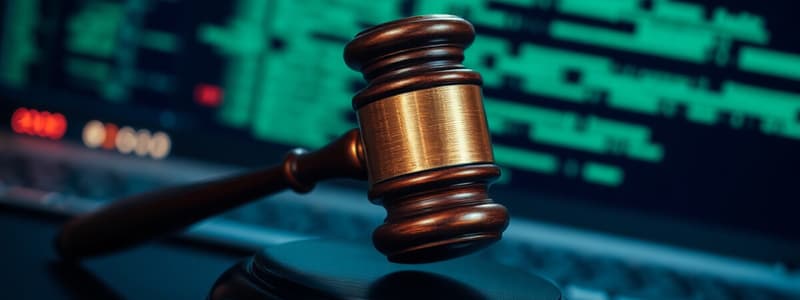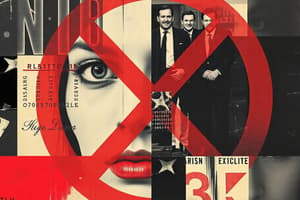Podcast
Questions and Answers
What was the primary aim of the Unlawful Internet Gambling Enforcement Act of 2006?
What was the primary aim of the Unlawful Internet Gambling Enforcement Act of 2006?
- To establish penalties for gambling
- To set age restrictions for online gambling
- To regulate online gambling taxes
- To regulate payment systems (correct)
What issue arises from the tension between the First Amendment and gambling regulations?
What issue arises from the tension between the First Amendment and gambling regulations?
- The impact on government revenue
- The need for free flow of information (correct)
- The requirement of gambling licenses
- The protection of children's identities
What major challenge is associated with international cooperation regarding online gambling?
What major challenge is associated with international cooperation regarding online gambling?
- Addressing regulations within the WTO (correct)
- Developing a unified tax system
- Enforcing gambling age restrictions
- Standardizing gambling platforms
What is a significant concern regarding technologically-generated images in the context of gambling?
What is a significant concern regarding technologically-generated images in the context of gambling?
Which law was considered insufficient to address the rise in online sports betting?
Which law was considered insufficient to address the rise in online sports betting?
What does the First Amendment protect in the context of computer-related crime?
What does the First Amendment protect in the context of computer-related crime?
Which of the following factors complicates the definition of obscenity?
Which of the following factors complicates the definition of obscenity?
What is the primary difference between indecent and obscene speech?
What is the primary difference between indecent and obscene speech?
Why is it challenging to establish community standards for obscenity?
Why is it challenging to establish community standards for obscenity?
How do courts generally differ concerning First Amendment protections?
How do courts generally differ concerning First Amendment protections?
What impact does the accessibility of material to children have on indecent speech?
What impact does the accessibility of material to children have on indecent speech?
What does the phrase 'I can't define it, but I know it when I see it' refer to?
What does the phrase 'I can't define it, but I know it when I see it' refer to?
How do technology-specific criminal laws impact the definition of forbidden content?
How do technology-specific criminal laws impact the definition of forbidden content?
What was the primary purpose of the Telecommunications Reform Act of 1996?
What was the primary purpose of the Telecommunications Reform Act of 1996?
What notable aspect did the Protection of Children Against Sexual Exploitation Act (1977) lack?
What notable aspect did the Protection of Children Against Sexual Exploitation Act (1977) lack?
Why does telephone communications receive heightened protection compared to other forms of media?
Why does telephone communications receive heightened protection compared to other forms of media?
What was the outcome of the Ashcroft v. Free Speech Coalition case regarding virtual child pornography?
What was the outcome of the Ashcroft v. Free Speech Coalition case regarding virtual child pornography?
What does the Communications Decency Act (CDA) criminalize?
What does the Communications Decency Act (CDA) criminalize?
What was identified as a compelling interest by the court regarding censorship?
What was identified as a compelling interest by the court regarding censorship?
What was a consequence of the lack of scienter in child pornography laws?
What was a consequence of the lack of scienter in child pornography laws?
Which of the following statements about cable TV is true?
Which of the following statements about cable TV is true?
The First Amendment provides protections against censorship of text and images available on a computer.
The First Amendment provides protections against censorship of text and images available on a computer.
All courts uniformly agree on what material is protected by the First Amendment.
All courts uniformly agree on what material is protected by the First Amendment.
Community standards on what is considered obscene are the same worldwide.
Community standards on what is considered obscene are the same worldwide.
Indecent speech can be broadcasted at any time without restrictions.
Indecent speech can be broadcasted at any time without restrictions.
Obscenity can be clearly defined without any ambiguity.
Obscenity can be clearly defined without any ambiguity.
Virtual images are treated the same as real images in defining obscenity.
Virtual images are treated the same as real images in defining obscenity.
Technology-specific criminal legislation generally provides clear definitions of forbidden content.
Technology-specific criminal legislation generally provides clear definitions of forbidden content.
The phrase 'I can’t define it, but I know it when I see it' relates to the concept of obscenity.
The phrase 'I can’t define it, but I know it when I see it' relates to the concept of obscenity.
The Unlawful Internet Gambling Enforcement Act of 2006 was created to regulate payment systems related to gambling activities.
The Unlawful Internet Gambling Enforcement Act of 2006 was created to regulate payment systems related to gambling activities.
The Old Wire Act of 1961 effectively addressed the increase in online sports betting.
The Old Wire Act of 1961 effectively addressed the increase in online sports betting.
There is an international consensus on the regulations regarding online gambling.
There is an international consensus on the regulations regarding online gambling.
The First Amendment guarantees the free flow of information, even in the context of gambling regulations.
The First Amendment guarantees the free flow of information, even in the context of gambling regulations.
Technologically-generated images pose no significant concerns in the realm of gambling regulations.
Technologically-generated images pose no significant concerns in the realm of gambling regulations.
Telephone communications and cable TV enjoy heightened levels of protection due to their pervasive nature.
Telephone communications and cable TV enjoy heightened levels of protection due to their pervasive nature.
The Telecommunications Reform Act of 1996 was designed to regulate cyberspace.
The Telecommunications Reform Act of 1996 was designed to regulate cyberspace.
The Protection of Children Against Sexual Exploitation Act (1977) required specific knowledge of age to secure a conviction.
The Protection of Children Against Sexual Exploitation Act (1977) required specific knowledge of age to secure a conviction.
Virtual child pornography was upheld as constitutionally protected in the case of Ashcroft v. Free Speech Coalition.
Virtual child pornography was upheld as constitutionally protected in the case of Ashcroft v. Free Speech Coalition.
The Communications Decency Act criminalizes obscene communication to minors.
The Communications Decency Act criminalizes obscene communication to minors.
Censoring entire categories of speech is considered an acceptable infringement by the court.
Censoring entire categories of speech is considered an acceptable infringement by the court.
The lack of scienter requirement did not lead to any legal challenges.
The lack of scienter requirement did not lead to any legal challenges.
The Telecommunications Reform Act also addressed issues of harassment and stalking in electronic mediums.
The Telecommunications Reform Act also addressed issues of harassment and stalking in electronic mediums.
Flashcards
UIGEA (2006)
UIGEA (2006)
Aimed to regulate online gambling payment systems, a critical part of these activities.
Old Wire Act (1961)
Old Wire Act (1961)
Outdated laws insufficient to handle the increase in online sports betting and bookmaking.
International cooperation (Gambling)
International cooperation (Gambling)
Lack of international cooperation hinders effective regulation of internet gambling.
Free Flow of Information
Free Flow of Information
Signup and view all the flashcards
Child Protection Online
Child Protection Online
Signup and view all the flashcards
Communications Decency Act (CDA)
Communications Decency Act (CDA)
Signup and view all the flashcards
Protection of Children Against Sexual Exploitation Act (1977)
Protection of Children Against Sexual Exploitation Act (1977)
Signup and view all the flashcards
Scienter
Scienter
Signup and view all the flashcards
Virtual child pornography
Virtual child pornography
Signup and view all the flashcards
Ashcroft v. Free Speech Coalition
Ashcroft v. Free Speech Coalition
Signup and view all the flashcards
Obscene communication to a minor
Obscene communication to a minor
Signup and view all the flashcards
Telephone/Cable protections
Telephone/Cable protections
Signup and view all the flashcards
Heightened protection
Heightened protection
Signup and view all the flashcards
First Amendment protections on computers
First Amendment protections on computers
Signup and view all the flashcards
Obscenity definition difficulties
Obscenity definition difficulties
Signup and view all the flashcards
Internet and obscenity
Internet and obscenity
Signup and view all the flashcards
Virtual vs. real images
Virtual vs. real images
Signup and view all the flashcards
Indecent vs. Obscene
Indecent vs. Obscene
Signup and view all the flashcards
Community standards and obscenity
Community standards and obscenity
Signup and view all the flashcards
Broadcasting limitations
Broadcasting limitations
Signup and view all the flashcards
First Amendment and computer crime
First Amendment and computer crime
Signup and view all the flashcards
First Amendment and Computers
First Amendment and Computers
Signup and view all the flashcards
Obscenity on the Internet
Obscenity on the Internet
Signup and view all the flashcards
Community Standards Matter
Community Standards Matter
Signup and view all the flashcards
Broadcasting Restrictions
Broadcasting Restrictions
Signup and view all the flashcards
Defining Obscenity
Defining Obscenity
Signup and view all the flashcards
Balancing Act
Balancing Act
Signup and view all the flashcards
First Amendment and Children Online
First Amendment and Children Online
Signup and view all the flashcards
Captive Audience
Captive Audience
Signup and view all the flashcards
Child Pornography and Scienter
Child Pornography and Scienter
Signup and view all the flashcards
Challenges to Traditional Notions of Decency
Challenges to Traditional Notions of Decency
Signup and view all the flashcards
Protection of Children Against Sexual Exploitation Act
Protection of Children Against Sexual Exploitation Act
Signup and view all the flashcards
Study Notes
Computer Forensics and Cyber Crime: Applying the First Amendment
- Protections against censorship of text and images, including those on computers, exist due to the First Amendment's guarantee of free speech.
- These protections create challenges for courts, as interpretations of First Amendment protection vary.
- Technology-specific criminal laws sometimes use vague descriptions of prohibited content, which could encompass emerging technologies' delivery methods.
Obscenity in General
- Defining obscenity is difficult. People can recognize it when they see it, but a precise definition is elusive.
- Community standards play a role, but vary significantly.
- The global nature of the Internet and virtual images complicates obscenity determinations, differing from real-world perceptions.
Traditional Notions of Decency
- Indecent speech, even if not obscene, may not be televised or broadcast during hours when children are likely to be in the audience. This can limit the free expression afforded by the First Amendment in certain circumstances.
- Telephone communications and cable TV have stronger First Amendment protections, as they don't often include captive audiences like broadcast media. This is because the audience is not passively receptive to such communications.
- Courts acknowledge the need to protect children, but broad censorship of speech is not permissible.
Emerging Statutes and Child Obscenity
- The Communications Decency Act (CDA) (1996) attempted to regulate the internet. It aimed to address the previously unregulated online frontier by criminalizing harassment, stalking, and offensive material directed toward minors online.
- The CDA also targeted materials considered obscene.
Traditional Attempts to Criminalize Child Pornography
- The Protection of Children Against Sexual Exploitation Act (1977) lacked a requirement for demonstrating the perpetrator knew the victim's age, resulting in a ruling of unconstitutionality.
Technology-Specific Legislation - Contention in the Courts
- The question of whether virtual child pornography increases child molesters' dangerousness was examined and refuted in Ashcroft v. Free Speech Coalition.
- This case served to overturn certain technologies-specific legislation regarding child pornography.
Internet Gambling Regulations
- The Old Wire Act of 1961 was insufficient to manage the growth of online sports betting and bookmaking.
- The Unlawful Internet Gambling Enforcement Act (UIGEA) in 2006 addressed this by regulating online gambling's payment systems.
International Cooperation & WTO
- There's a lack of international cooperation regarding Internet gambling laws, and this impacts global enforcement efforts. The WTO plays a role in these discussions.
Future Issues and Conclusions
- A tension exists between protecting the free flow of information and protecting children from harmful material.
- Legal issues persist surrounding the definition of protected material delivered using emerging technologies. This includes technologically-generated (or altered) images & their potential impact.
Studying That Suits You
Use AI to generate personalized quizzes and flashcards to suit your learning preferences.




